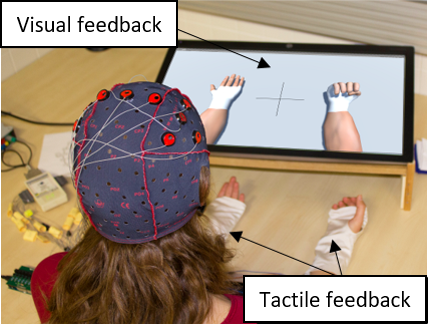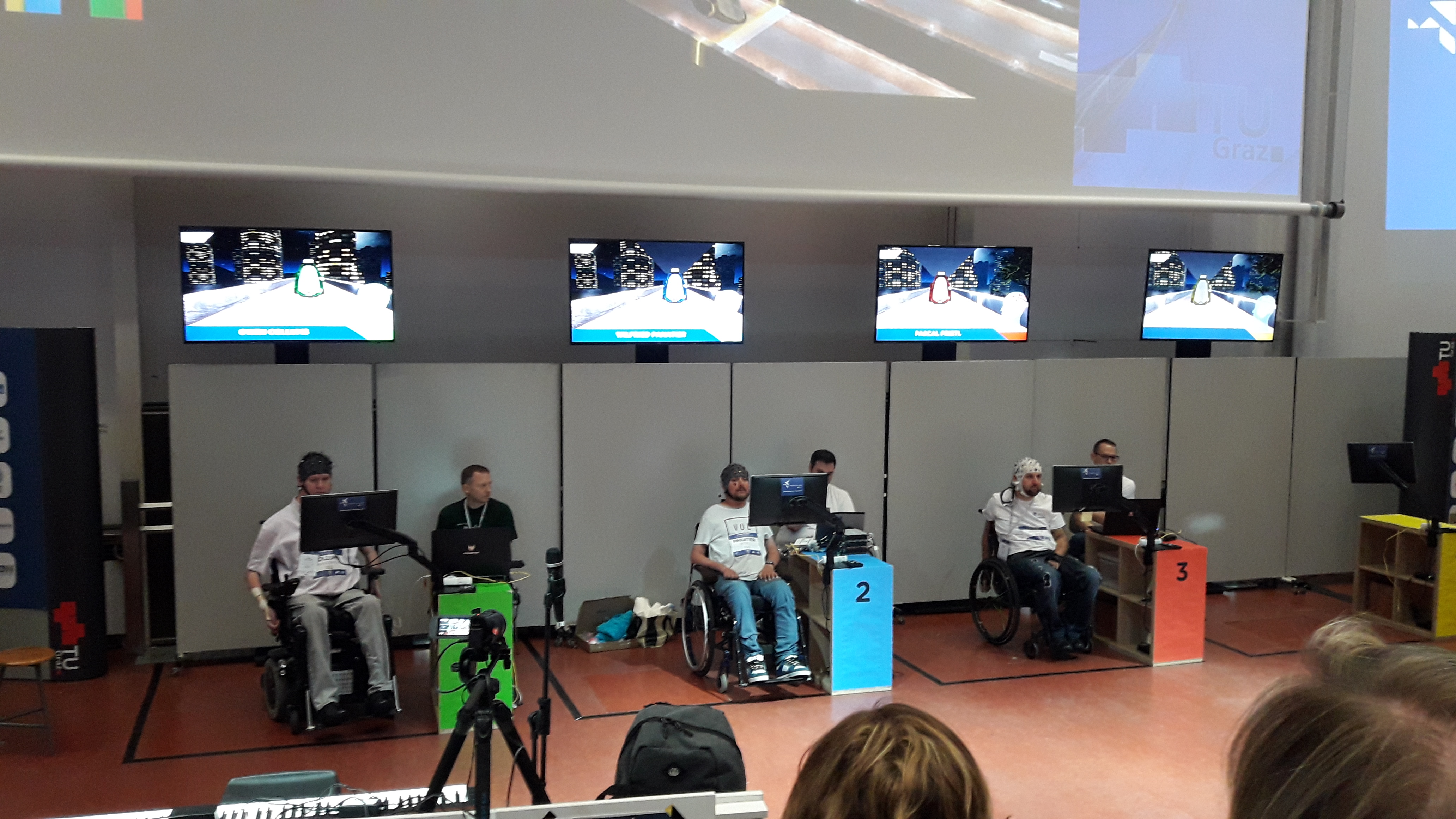Section: New Results
Redefining and optimizing BCI user training tasks, stimulations and feedback
Participants: Jelena Mladenovic, Smeethy Pramij, Léa Pillette, Romain Sabau, Fabien Lotte
External collaborators: Jérémy Frey, Jérémie Mattout, Matteus Joffily, Emmanuel Maby, Bertrand Glize, Bernard N'Kaoua, Pierre-Alain Joseph, Camille Jeunet, Roger N'Kambou, Boris Mansencal
Active inference as a unifying, generic and adaptive framework for a P300-based BCI: We proposed the use of a generic, computational framework – Active (Bayesian) Inference to automatically lead the adaptation process in a P300 speller BCI. It adapts through the use of a probabilistic model of the user built upon user's reactions to flashing/spelled letters. Using such observations, at each iteration it updates its beliefs about user intentions, and converges towards a predefined goal, i.e. correctly spelled letters. Active Inference is a recent computational neuroscience approach that models learning and decision making of the brain. As such, by endowing such model to the BCI machine, it enables the machine to adapt in a similar fashion as the brain would. We demonstrate an implementation of Active Inference on a simulated P300-Speller BCI, with real EEG data from 18 subjects. Results demonstrate the ability of Active Inference to yield a significant increase in bit rate (17%) over state-of-the-art approaches. This work was published in Journal of Neural Engineering in [18].
Towards adaptive and adapted difficulty for MI-BCI user training: We investigated the relationship between the human factors and BCI performance during MI-BCI training. Additionally, we investigated the influence of user personality traits and states on learning the MI skill, i.e., evolution of performance over a session. We conducted a MI experiment in which we influence the user through task difficulty. We acquire data to build a predictive model that could unveil which kind of task is optimal for what kind of user. Moreover, depending on what we set to be predicted, be it a flow state or performance, it can serve as a guide for overall adaptation, i.e., it can serve as an optimization criteria to wager between user experience and system accuracy for instance. We then used priors on user traits and states acquired from the prediction models to perform a simple adaptive method which provides optimal task difficulty to each user. To demonstrate the usefulness of the model for maximizing performance, we perform a simulation using real data from the MI-BCI experiment mentioned above. This work was presented in the PhD thesis of Jelena Mladenovic, that was successfully defended on September 10th, 2019.
Impact of MI-BCI feedback for post-stroke and neurotypical people: We investigated how the modality of the feedback could be adapted to the learners. First, based on a review of the literature, we argued that somatosensory abilities of post-stroke patients have not, but should be, taken into account for BCI-based motor therapies. Indeed, somatosensory abilities play an important role in motor rehabilitation in general, and in BCI-based therapies in particular. It is assumed that during BCI based therapies the co-activation of ascending (i.e., somatosensory) and descending (i.e., sensorimotor) networks enables significant functional motor improvement, together with significant sensorimotor-related neurophysiological changes. Somatosensory abilities seem essential for the patients to benefit from the feedback provided by the BCI system. Yet, around half of post-stroke patients suffer from somatosensory deficits. We hypothesize that these deficits alter their ability to benefit from BCI-based therapies. Our review of the literature on BCI-based motor rehabilitation post-stroke of 14 randomized clinical trials indicates that somatosensory abilities were rarely considered and/or reported. Only two studies over the fourteen reported using them as inclusion/exclusion criteria. Though, none of these two studies reported how they assess the somatosensory abilities. We argue that assessing the somatosensory abilities of the patients is necessary to avoid any bias and enable reliable comparison between-subject and between-study. It could also be leveraged to improve our understanding of the underlying mechanisms of motor recovery and adapt the therapy to the patients' abilities.
Our review of the literature also informed us that a multimodal feedback composed of both somatosensory and visual feedback enables better performances than an unimodal visual feedback, at least in the short term. Though, the long term influence of such feedback remained unknown. Therefore, we assessed the long term effects of a multimodal feedback composed of both vibrotactile and realistic visual stimulations (presented in [43], see also Figure 10), and a unimodal feedback with only realistic visual stimulations. We found that the beneficial impact of a multimodal feedback composed of both visual and somatosensory stimulation compared to a visual feedback alone remains true even for long term training, which had not been tested before. Also, the order of presentation of the different modalities of feedback might have an influence. Using an unimodal visual feedback only seems to be better suited for untrained participants. We hypothesis that integrating information arising from two modalities of feedback while performing the task could be particularly challenging for a novice learner. Both these works were presented in the PhD thesis of Léa Pillette, that was successfully defended on December 16th, 2019.
A physical learning companion for Mental-Imagery BCI User Training: We continued our work on PEANUT, that we designed, implemented and tested, and which is the first learning companion dedicated to providing social presence and emotional feedback during MI-BCI user training. PEANUT provided social presence and emotional support, depending on the performance and progress of the user, through interventions combining both pronounced sentences and facial expressions. It was designed based on the literature, data analyses and user-studies. We notably conducted several online user surveys to identify the desired characteristics of our learning companion in terms of appearance and supporting speech content. From the results of these surveys we notably deduced which should be the characteristics (personal/non-personal, exclamatory/declarative) of the sentences to be used depending on the performance and progression of a learner. We also found that eyebrows could increase expressiveness of cartoon-like faces. Then, once this companion was implemented, we evaluated it during real online MI-BCI use. We found that non-autonomous people, who are more inclined to work in a group and are usually disadvantaged when using MI-BCI, were advantaged compared to autonomous people when PEANUT was present with an increase of 3.9% of peak performances. Furthermore, in terms of user experience, PEANUT seems to have improved how people felt about their ability to learn and memorize how to use an MI-BCI by 7.4%, which is a dimension of the user experience we assessed. This work was published in the International Journal of Human-Computer Studies in [19].
Long-term mental imagery BCI training of a tetraplegic user: We participated to the Cybathlon BCI series 2019 competition in Graz (https://www.tugraz.at/institutes/ine/graz-bci-conferences/8th-graz-bci-conference-2019/cybathlon-bci-series-2019/), as team NITRO (Neurotechnology Inria Team Racing Odyssey), during which we trained a tetraplegic user over several months, with up to 3 training sessions per week, to learn to control a 4-class and self-paced mental imagery BCI connected to a racing video game (see Figure 11). This training and the resulting BCI design used several of our recent research and development works, notably new OpenViBE development on the feedback, progressive user training and adaptive Riemannian EEG classifiers [41].




